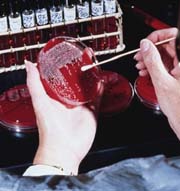
Certain FDA regulations help assure the safety of low-acid and acidified foods in hermetically sealed containers. These rules do not cover products with a water activity level of less than 0.85 because food pathogens generally do not grow below a range of 0.95. See chart “Limited Opportunity for Growth.”
As the water activity of foods and ingredients is lowered, fewer organisms are able to grow in the product. The only pathogen capable of growing below 0.90 is S. aureus. Research indicates this organism may produce enterotoxin at water activities as low as 0.867. Intermediate-moisture foods also are regulated to Aw levels of 0.85 or below to assure microbiological safety.
Reducing water activity, along with the use of mild heat, organic acids or other antimicrobials, creates a hostile environment for microorganisms. When producing dry ingredients, blended products or other foods, understanding the water activity of each of the components of a food system helps ensure the products look, perform or taste as expected.
For example, cereals with dried fruit in them have two elements with different moisture levels. When the products are mixed together, they equilibrate: moisture migrates from the higher moisture component (the dried fruit) to the lower (the cereal). The end result is dried fruits that are hard and undesirable. To overcome this, the fruits are “plumped,” using humectants. The materials minimize the transfer of water between the fruit and cereal, so the fruits remain plump and soft.
Measuring Aw Levels
There are two basic types of commercially available instruments to measure water activity. One uses chilled dew point technology and the other measures relative humidity. The dew point is the temperature at which air reaches saturation. When using such an instrument, the water activity is determined by measuring the ratio of the saturation vapor pressure at the dew point to the saturation vapor pressure at the product temperature. Instruments that measure dew point are most commonly used in the food industry. They are accurate, fast, easy to use and precise.
Decagon Devices (Pullman, Wash.) offers a series of instruments for measuring water activity under the AquaLab brand: the AquaLab Series 3 TE, the Series 3 and the PawKit. The AquaLab Series 3 model TE is a temperature-controlled water activity meter that allows users to have a temperature-stable sampling environment without an external water bath. The “TE” stands for thermoelectric or Peltier control. The TE feature allows the user to choose (on-screen) which temperature he intends to employ during testing. The temperature then is monitored and controlled with internal thermoelectric components. This unit is recommended for companies doing research (such as conducting shelflife or isotherm studies).
The Series 3 has the same range and accuracy as the TE units, but does not have the temperature control features. This unit may be used as a quality monitoring tool in a laboratory environment. Both of these units are accurate to levels of 0.003.
The PawKit is a mobile, hand-held unit. It does not have the accuracy of the aforementioned instruments, but may be used in operations that do not require the precision of the benchtop units.
The Decagon Devices staff provides both in-plant assistance and technical support, and work with processors on problems related to moisture in foods and ingredients.
For more information:
Decagon Devices Inc., Justin Marley
509-332-2756, sales@decagon.com,
www.decagon.com